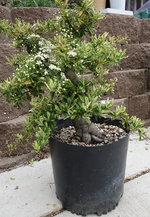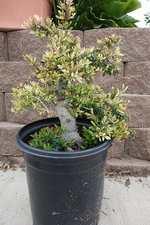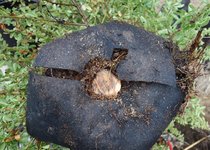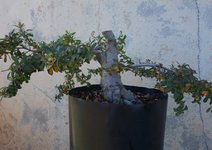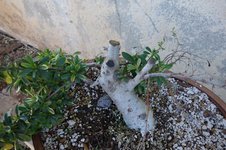Pyracantha, variety Cadvar, aka 'Silver Lining'.

I found two nicely-fattened specimens at a local nursery about a year ago, but of course the catch was that they’re a variegated type that nobody else wanted for years! I couldn’t find much info on them except that they rarely have berries, and bronze a burgundy color in the winter. They’re also less cold hardy, which shouldn’t be a problem in 10b, but I'll still cold shield them better in future years because they did suffer some wind/frost burn this year. I’m not super thrilled by variegated species, but they have small leaves--which get even smaller after pruning, and this also seems to minimize the variegation trait, so win-win. The game plan for both is informal upright. I know they’re still too tall yet--I plan to cut the trunks down another inch or two once they start growing vigorously again.
Specimen #1 The roots aren’t radial, but the flare is interesting in its own way. The main flaw I don't like is the 'first branch'. To avoid creating a big scar that probably wouldn’t heal, I chopped the existing branch short and hoped it would sprout new growth off the front that would hide the cut. But of course it produced an eye-poker off the bottom that had to be wired over hard. In hindsight I shouldn't have cut the branch so short. I’m still debating whether I should try shaving the transition down, or just chop it all off and live with a scar.


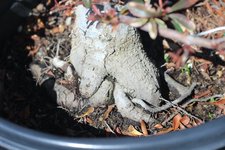
First branch debacle:

Specimen #2 It has some considerable flaws. The whole backside is a massive scar where I removed a hideous bar branch, and it has some inverse taper. Eventually when it’s stronger, I plan to air layer right at the ground to remove that taper and develop better nebari. It's also got some serious sucker activity--which I haven't removed because after I air-layer it, I might try to develop a forest raft from the stump. I dunno--it's a thought.

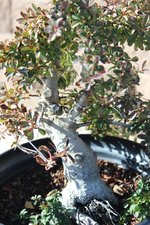
The bad side:

This year the plan is just to feed heavy and manage the resulting growth. But I wonder if I should repot them now too? I know it’s unlikely that anyone here has worked with this variety, but in general do pyracantha handle root work well? They’re going to have some massive roots to reduce--at one time they’d rooted out through the drain holes before being hacked off by the nursery staff. But if pyracantha hate root work, perhaps I should build up their strength for a another year first. I'm open to thoughts on the design. These are my first attempt at styling informal uprights.

I found two nicely-fattened specimens at a local nursery about a year ago, but of course the catch was that they’re a variegated type that nobody else wanted for years! I couldn’t find much info on them except that they rarely have berries, and bronze a burgundy color in the winter. They’re also less cold hardy, which shouldn’t be a problem in 10b, but I'll still cold shield them better in future years because they did suffer some wind/frost burn this year. I’m not super thrilled by variegated species, but they have small leaves--which get even smaller after pruning, and this also seems to minimize the variegation trait, so win-win. The game plan for both is informal upright. I know they’re still too tall yet--I plan to cut the trunks down another inch or two once they start growing vigorously again.
Specimen #1 The roots aren’t radial, but the flare is interesting in its own way. The main flaw I don't like is the 'first branch'. To avoid creating a big scar that probably wouldn’t heal, I chopped the existing branch short and hoped it would sprout new growth off the front that would hide the cut. But of course it produced an eye-poker off the bottom that had to be wired over hard. In hindsight I shouldn't have cut the branch so short. I’m still debating whether I should try shaving the transition down, or just chop it all off and live with a scar.



First branch debacle:

Specimen #2 It has some considerable flaws. The whole backside is a massive scar where I removed a hideous bar branch, and it has some inverse taper. Eventually when it’s stronger, I plan to air layer right at the ground to remove that taper and develop better nebari. It's also got some serious sucker activity--which I haven't removed because after I air-layer it, I might try to develop a forest raft from the stump. I dunno--it's a thought.


The bad side:

This year the plan is just to feed heavy and manage the resulting growth. But I wonder if I should repot them now too? I know it’s unlikely that anyone here has worked with this variety, but in general do pyracantha handle root work well? They’re going to have some massive roots to reduce--at one time they’d rooted out through the drain holes before being hacked off by the nursery staff. But if pyracantha hate root work, perhaps I should build up their strength for a another year first. I'm open to thoughts on the design. These are my first attempt at styling informal uprights.





